Creating the Spatial Utilization Pattern of Traditional Villages in the Yellow River by Connecting the Heritage Corridors System with the Assessment of Tourism Potential
Abstract
1. Introduction
2. Materials and Methods
2.1. Technical Route
2.2. Research Area
2.3. Methods
2.3.1. An Indicator System for Evaluating Tourism Potential
2.3.2. Combined Weight Method
2.3.3. Minimum Cumulative Resistance
3. Results
3.1. Spatial Distribution of Traditional Villages
3.2. Tourism Potential Assessment of Traditional Villages
3.3. Extracting the Cost Paths of Traditional Villages with Different Tourism Potential
4. Discussion
4.1. Spatial Distribution Characteristics of the Traditional Villages
4.2. Spatial Utilization Pattern of Traditional Villages in Yellow River Basin
4.2.1. The Four Cores of Spatial Utilization Pattern
4.2.2. The Seven Cultural Zones of Spatial Utilization Pattern
| Cultural Zone | Characteristics | Represented Cultural Heritage |
|---|---|---|
| Hehuang | It exemplifies a harmonious coexistence of grassland and agricultural cultures. Multicultural environment fosters cultural exchanges, integration, and coexistence among these diverse groups. A variety of religions, such as Han Buddhism, Tibetan Buddhism, Taoism, and Islam, coexist and interweave, resulting in a rich tapestry of regional, ethnic, and religious cultures [56]. | 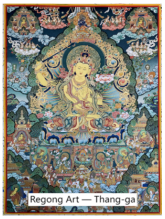 |
| Xixia | Long–standing interactions among the Dangxiang, Han, Tubo, Uyghur, and other ethnic groups have been significantly shaped by the influences of Silk Road culture, as well as Central Asian and Western regional cultures. This has led to a vibrant exchange and integration of diverse cultural elements, including art, military traditions, clan structures, etiquette, and customs, with the XiXia script serving as a notable example [57]. | 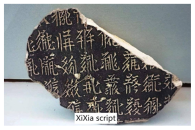 |
| Hetao | The Xiongnu, Mongolian, and other nomadic peoples have multiplied here, and have contributed to a rich array of primitive cultural artifacts. These groups have preserved their nomadic traditions of horseback riding and archery while also adopting agricultural practices, thereby integrating into the broader borderland culture characterized by cultural diversity and symbiotic relationships [58]. | 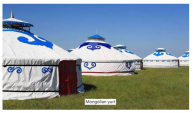 |
| Sanqin | Tracing its origins to the Zhou and Qin dynasties, it possesses a long history marked by significant agricultural and farming cultural traits, alongside a wealth of ethnic diversity. The local customs are characterized by simplicity and vitality, with a deep cultural heritage that encompasses a variety of folk activities, including temple fairs, Shehuo, and shadow puppetry [59]. | 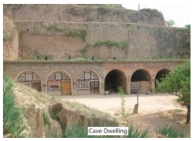 |
| Sanjin | The cultural lineage can be traced back to the Yao and Shun periods, showcasing a rich historical background. The Buddhist culture of northern Shanxi, the merchant culture of Jin in central Shanxi, and the root–seeking culture of southern Shanxi collectively contribute to a diverse Shanxi culture, characterized by its inclusivity [60]. | 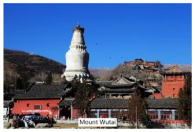 |
| Central Plains | As a crucial cradle of Chinese civilization, it boasts profound historical and cultural deposits, which exhibit unique cultural characteristics and a tradition of inclusivity. It has also demonstrated remarkable capabilities in scientific and technological innovation, being the origin of all four of the Great Inventions of ancient China [61]. |  |
| Qilu | The culture is prominently represented by “rites and music culture” and “etiquette culture”, resulting from the organic integration of Western Zhou culture, Dongyi culture, Confucian thought, and Taoist thought. This synthesis has given rise to a cultural system centered on Confucianism, which emphasizes the importance of ritual and music education, family ethics, and clan systems, while also highlighting the hierarchical distinctions of seniority and junior status, as well as the concept of the unity of family and state [32]. | 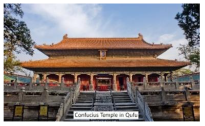 |
4.2.3. The Multiple Corridors of Spatial Utilization Pattern
4.3. Limitation
5. Conclusions
Author Contributions
Funding
Data Availability Statement
Conflicts of Interest
Abbreviations
| MDPI | Multidisciplinary Digital Publishing Institute |
| DOAJ | Directory of Open Access Journals |
| TLA | Three Letter Acronyms |
| LD | Linear Dichroism |
| YRB | Yellow River Basin |
| CWM | Combined Weighting Method |
| AHP | Analytic Hierarchy Process |
| EWM | Entropy Weight Method |
| MCR | Minimum Cumulative Resistance |
Appendix A
| Aspect | Indicators | Weight | Classification |
|---|---|---|---|
| Natural environment | Slope | 0.0014 | Below 3° = 5; 3–6° = 4; 6–10° = 3; Above 10° = 2 |
| Elevation | 0.0017 | Up to 500 m = 5; 500–1000 m = 4; 1000–2000 m = 3; 2000–3200 m = 2; Above 3200 m = 1 | |
| Distance from river | 0.0069 | 500–1000 m = 5; Below 500 m = 4; 1000–1800 m = 3; 1800–3200 m = 2; Above 3200 m = 1 | |
| Average temperature | 0.0056 | 11–13° C = 5; Above 13 °C = 4; 8–11 °C = 3; 4–8 °C = 2; Below 4 °C = 1 | |
| Precipitation | 0.0152 | 300–550 mm = 5; 500–550 mm = 4; Above 550–600 mm = 3; 600–900 mm = 2; Below 300 or Above 900 mm = 1 | |
| NDVI | 0.0040 | 0.3–0.45 = 5; 0.45–0.7 = 4; 0.2–0.3 = 3; 0.1–0.2 = 2; | |
| Transportation accessibility | Number of railway stations, high–speed railway stations, airports | 0.0577 | 4 or More = 5; 2–4 = 4; 0–2 = 3; 0 = 0 |
| Travel time to the nearest highway entrance | 0.0032 | Up to 2 h = 5; 1–7 h = 4; 7–9 h = 3; 9–12 h = 2; More than 12 h = 1 | |
| Travel time to the nearest county | 0.0109 | Up to 2 h = 5; 1–7 h = 4; 7–9 h = 3; 9–12 h = 2; More than 12 h = 1 | |
| Society and economy | GDP per capita | 0.1003 | Over ¥130,000 = 5; ¥100,000~130,000 = 4;¥60,000~100,000 = 3; ¥30,000~60,000 = 2;Below ¥30,000 = 1 |
| Population density | 0.2818 | 400 persons/km2 = 5; 240~400 persons/km2 = 4; 120~240 persons/km2 = 3; 60~120 persons/km2 = 2; Below 60 persons/km2 = 1 | |
| Cultural heritage sites | Number of national and provincial–level cultural relics protection units in the county | 0.2439 | 50 Points and Above = 5; 30–50 Points = 4; 20–30 Points = 3; 10–20 Points = 2; 1–10 Points = 1 (2 points each at the national level and 1 point at the provincial level) |
| Number of national and provincial–level intangible cultural heritages in the county | 0.0463 | 20 Points and Above = 5; 13–20 Points = 4; 8–13 Points = 3; 5–8 Points = 2; 1–5 Points = 1 (2 points each at national level, 1 point at provincial level) | |
| Tourism condition | Number of hotels above three – star in the county | 0.1256 | 70 Points and Above = 5; 40–70 Points = 4; 15–40 Points = 3; 5–15 Points = 2; 0–5 Points = 1 (3 points per 5–star, 2 points per 4–star, 1 point per 3–star) |
| Number of regulations and policies related to cultural tourism at city and county levels | 0.0172 | 18 Points and Above = 5; 14–18 Points = 4; 10–14 Points = 3; 7–10 Points = 2; Up to 7 Points = 1 (2 points per municipality, 1 point per province) | |
| Disposable income of rural residents in counties | 0.0367 | ¥20,000 or More = 5; ¥16,000–¥20,000 = 4;¥13,000–¥16,000 = 3; ¥10,000–¥13,000 = 2; Under ¥10,000 = 1 | |
| Number of scenic spots above 3A in the county | 0.0418 | 18 Points and Above = 5; 12–18 points = 4; 7–12 Points = 3; 3–7 Points = 2; 3 Points or less = 1 (1 point per 3A, 2 Points per 4A, 3 points per 5A) |
References
- Housing and Urban-Rural Development Ministry, Culture Ministry, National Cultural Heritage Administration, Ministry of Finance. Notice on the Survey of Traditional Villages. Available online: https://www.mohurd.gov.cn/gongkai/zc/wjk/art/2012/art_17339_209619.html (accessed on 10 October 2024).
- Cai, H.; Yu, J.; Guo, Y. Spatial and temporal distribution and evolution of traditional villages in Xin’an River Basin of China based on geographic detection and remote sensing technology. Ecol. Indic. 2025, 171, 113239. [Google Scholar] [CrossRef]
- Zhao, X.; Xue, P.; Wang, F.; Qin, Y.; Duan, X.; Yang, Z. How to become one? The modern bond of traditional villages in centralized contiguous protection and utilization areas in China. Habitat Int. 2024, 145, 103018. [Google Scholar] [CrossRef]
- Flink, C.H.; Searns, R.M. Greenways: A Guide to Planning, Design and Development; Island Press: Washington, DC, USA, 1993. [Google Scholar]
- President’s Commission on Americans Outdoors. Americans Outdoors: The Legacy, the Challenge, with Case Studies; Island Press: Washington, DC, USA, 1987; p. 209.
- Conzen, M.P.; Wulfestieg, B.M. Metropolitan Chicago’s Regional Cultural Park: Assessing the Development of the Illinois & Michigan Canal National Heritage Corridor. J. Geogr. 2001, 100, 111–117. [Google Scholar]
- Wantzen, K.M.; Schmitt, L.; Wirbelauer, E. The Rhine—An Important Biocultural Axis for Europe. In River Culture—Life as a Dance to the Rhythm of the Waters; Wantzen, K.M., Ed.; UNESCO: Paris, France, 2022; pp. 561–587. [Google Scholar]
- Murray, M. The cultural heritage of pilgrim itineraries: The Camino de Santiago. Journeys 2014, 15, 65–85. [Google Scholar] [CrossRef]
- Yang, P.; Lu, Y.; Yang, D.; Ren, Z. Protection and activation of cultural heritage from the perspective of heritage corridors: A case study of the Dazhangxi Corridor (Fuzhou section). Planner 2024, 40, 123–130. [Google Scholar]
- Chong, Z. Profound Evaluation and Rediscovery of the Heritage Corridor: Historical Geographical Pre-Exploration and Analysis of Linear Historical Landscape in Japan. Landsc. Archit. 2021, 28, 10–14. [Google Scholar]
- Sok, S.; Nguonphan, P.; Hem, T. Cultural Corridor and Heritage Tourism Development in Cambodia. In The Palgrave Handbook of Global Social Change; Springer International Publishing: Cham, Switzerland, 2023; pp. 1–18. [Google Scholar]
- Kashid, M.; Ghosh, S.; Narkhede, P. A Conceptual Model for Heritage Tourism Corridors in the Marathwada Region. In Proceedings of the National Online Conference on Planning, Design and Management, Pune, India, 6–7 May 2022; pp. 6–7. [Google Scholar]
- Yan, L.; Gao, B.W.; Zhang, M. A mathematical model for tourism potential assessment. Tour. Manag. 2017, 63, 355–365. [Google Scholar] [CrossRef]
- Shohan, R.; Toleuuly, A.; Assadova, Z.K. Tourist potential and prospects of tourism industry of Kazakhstan. Educ. Sci. Without Bord. 2012, 3, 34. [Google Scholar]
- Loren-Méndez, M.; Maes, J.; Pinzón-Ayala, D.; Alonso-Jiménez, R.F. Accessibility to heritage knowledge: Emerging modern heritage and cultural tourism roads and infrastructures as cultural corridors. In Handbook on Heritage, Sustainable Tourism and Digital Media; Edward Elgar Publishing: Cheltenham, UK, 2022; pp. 98–106. [Google Scholar]
- Hua, Z.; Jamaludin, O.; Ing, D.S. A review on traditional villages protection and development in China. Construction 2024, 4, 140–149. [Google Scholar] [CrossRef]
- Puška, A.; Pamucar, D.; Stojanović, I.; Cavallaro, F.; Kaklauskas, A.; Mardani, A. Examination of the Sustainable Rural Tourism Potential of the Br? ko District of Bosnia and Herzegovina Using a Fuzzy Approach Based on Group Decision Making. Sustainability 2021, 13, 583. [Google Scholar] [CrossRef]
- Sobhani, P.; Esmaeilzadeh, H.; Sadeghi, S.M.M.; Wolf, I.D. Land potential for ecotourism development and assessing landscape ecology in areas on protection of Iran. Environ. Dev. Sustain. 2024, 26, 8103–8137. [Google Scholar] [CrossRef]
- Huang, H.; Miao, H.; Wang, Y. Evaluation research on the tourism development potential of traditional villages in Northwest China. J. Geogr. Sci. Dev. 2021, 40, 106–110+117. [Google Scholar]
- Aytuğ, H.K.; Mikaeili, M. Evaluation of Hopa’s rural tourism potential in the context of European Union tourism policy. Procedia Environ. Sci. 2017, 37, 234–245. [Google Scholar] [CrossRef]
- Xie, Z.; Song, J.; Zhang, H.; Wang, Y. Comprehensive evaluation of tourism development potential of cultural landscape in Fenhe River Basin. J. Desert Res. 2024, 44, 184–192. [Google Scholar]
- Zhan, Y.; Zhang, Y.; Zhang, J.; Xu, J.; Chen, H.; Liu, G.; Wan, Z. Risk assessment of land subsidence in Shanghai municipality based on AHP and EWM. Sci. Rep. 2025, 15, 7339. [Google Scholar] [CrossRef]
- Yin, L.J.; Yi, J.; Lin, Y.; Lin, D.; Wei, B.; Zheng, Y.; Peng, H. Evaluation of green mine construction level in Tibet based on entropy method and TOPSIS. Resour. Policy 2024, 88, 104491. [Google Scholar] [CrossRef]
- Nie, X.; Xie, Y.; Xie, X.; Zheng, L. The characteristics and influencing factors of the spatial distribution of intangible cultural heritage in the Yellow River Basin of China. Herit. Sci. 2022, 10, 121. [Google Scholar] [CrossRef]
- Li, W.; Jiao, J.; Qi, J.; Ma, Y. The spatial and temporal differentiation characteristics of cultural heritage in the Yellow River Basin. PLoS ONE 2022, 17, e0268921. [Google Scholar] [CrossRef]
- Zhang, H.; Wang, Y.; Qi, Y.; Chen, S.; Zhang, Z. Assessment of Yellow River region cultural heritage value and corridor construction across urban scales: A case study in Shaanxi, China. Sustainability 2024, 16, 1004. [Google Scholar] [CrossRef]
- Yang, X.W.; Wei, G.; Liang, C.; Yang, Z.; Fang, H.; Zhang, S. Construction of ecological security pattern based on ecosystem service evaluation and minimal cumulative resistance model: A case study of Hefei City, China. Environ. Dev. Sustain. 2024, 26, 10681–10700. [Google Scholar] [CrossRef]
- Na, Y.Q.; Hong, Z.; Ren, S.; Huang, K. Optimizing the construction of ecological networks in Beijing using a morphological spatial pattern analysis—Minimal cumulative resistance model. Front. Environ. Sci. 2024, 12, 1325880. [Google Scholar] [CrossRef]
- Zhao, X.; Tang, C.; Dong, P.; Wang, J.; Shi, J. Construction of a Composite Tourism Corridor for Linear Heritage: A Case Study. Arid Land Resour. Environ. 2023, 37, 190–199. [Google Scholar] [CrossRef]
- Ge, J. The Yellow River and Chinese Civilization. Yell. Loess. Yell. Race 2025, 9, 4–13. [Google Scholar]
- Wang, Y. Spanning Time and Space: The Inheritance and Protection of Cultural Heritage in Shanxi. Rep. Obs. 2025, 7, 7–15. [Google Scholar]
- Fan, C.; Ma, S. The Historical Contributions and Inheritance Value of Qilu Culture in Enhancing the Cohesion of the Chinese Nation. J. Anc. Mod. Creat. Cult. 2025, 14, 111–114. [Google Scholar] [CrossRef]
- Xu, X. Exploration of the pathways for high-quality development in the Yellow River Basin: Integrated development of ecology, culture and economy, zoning and overall planning. Yellow River Civiliz. Sustain. Dev. 2021, 1, 71–87. [Google Scholar]
- Traditional Village Network. Available online: http://chuantongcunluo.com (accessed on 12 September 2024).
- National Cryosphere Desert Data Center. Available online: http://www.ncdc.ac.cn (accessed on 18 October 2024).
- National Catalogue Service for Geographic Information. Available online: https://www.webmap.cn (accessed on 18 October 2024).
- Resource and Environment Science Data Platform. Available online: https://www.resdc.cn (accessed on 18 October 2024).
- Yu, H.; Wang, Y.; Li, D. Using the AHP-entropy weight method to study regional marine economy resilience in China. J. Coast. Res. 2023, 39, 960–969. [Google Scholar] [CrossRef]
- Li, Y.-Y.; Zhang, Y.-Z.; Jiang, Z.-Y.; Guo, C.-X.; Zhao, M.-Y.; Yang, Z.-G.; Guo, M.-Y.; Wu, B.-Y.; Chen, Q.-L. Integrating morphological spatial pattern analysis and the minimal cumulative resistance model to optimize urban ecological networks: A case study in Shenzhen City, China. Ecol. Process. 2021, 10, 63. [Google Scholar] [CrossRef]
- Zhang, T.; Chen, X.; Liu, T. Linear cultural heritage eco-cultural spatial system: A case study of the Great Tea Route in Shanxi. Front. Archit. Res. 2025, 14, 1063–1075. [Google Scholar] [CrossRef]
- Ye, H.; Yang, Z.; Xu, X. Ecological Corridors Analysis Based on MSPA and MCR Model—A Case Study of the Tomur World Natural Heritage Region. Sustainability 2020, 12, 959. [Google Scholar] [CrossRef]
- Lin, F.; Zhang, X.; Ma, Z.; Zhang, Y. Spatial structure and corridor construction of intangible cultural heritage: A case study of the Ming Great Wall. Land 2022, 11, 1478. [Google Scholar] [CrossRef]
- Li, X.; Zhu, R.; Shi, C. Research on the construction of intangible cultural heritage corridors in the Yellow River Basin based on GIS and MCR model. Herit. Sci. 2024, 12, 271. [Google Scholar] [CrossRef]
- Yue, F.; Li, X.; Huang, Q.; Li, D. A Framework for the Construction of a Heritage Corridor System: A Case Study of the Shu Road in China. Remote Sens. 2023, 15, 4650. [Google Scholar] [CrossRef]
- Huang, Y.; Xue, Q. Spatio-Temporal distribution characteristics and driving factors of traditional villages in the Yellow River Basin. PLoS ONE 2024, 19, e0303396. [Google Scholar] [CrossRef]
- Gao, C.; Wu, Y.; Bian, C.; Gao, X. Spatial characteristics and influencing factors of Chinese traditional villages in eight provinces the Yellow River flows through. River Res. Appl. 2023, 39, 1255–1269. [Google Scholar] [CrossRef]
- Hu, H.Y. Discussion on the approaches to high-quality development of the population in the Yellow River Basin: Distribution, regionalization and prospect. Acta Geogr. Sin. 1990, 2, 139–145. [Google Scholar]
- He, W.P.; Zhou, S.Z.; Guo, W.J. Study on the population distribution characteristics and influencing factors in the Yellow River Basin. J. Mianyang Teach. Coll 2022, 41, 100–107. [Google Scholar]
- Li, Y.X. Research on Hehuang culture from the perspective of Yellow River culture. China Tu Natly. 2024, 4, 9–12. [Google Scholar]
- Tian, Z. Application research of Xixia cultural elements in the architectural design of homestays. Beauty Times (Urban Ed.) 2021, 5, 34–35. [Google Scholar]
- Yan, X.X.; Zhang, Y.F. Research on the folk culture of Hetao in the “Jiuziwan” area of the Yellow River in Inner Mongolia. Masterpieces Apprec. 2025, 9, 30–32. [Google Scholar] [CrossRef]
- Dong, Y. Reconstruction and Promotion of Guanzhong Folk Village Landscape Based on the Perception of Sanqin Culture. Master’s Thesis, Xi’an University of Architecture and Technology, Xi’an, China, 2019. [Google Scholar] [CrossRef]
- Huang, X.J. Application Research of Sanjin Culture in the Packaging Design of Shanxi Tourism Souvenirs. Master’s Thesis, Shenyang Normal University, Shenyang, China, 2020. [Google Scholar] [CrossRef]
- Olberding, A. Etiquette: A confucian contribution to moral philosophy. J. Ethics 2016, 126, 422–446. [Google Scholar] [CrossRef]
- Li, Q.Q. Research on the integrated development of Qilu ancient village culture and digital cultural tourism under the rural revitalization strategy. Bus. Exhib. Econ. 2025, 5, 59–62. [Google Scholar] [CrossRef]
- Gu, S. The charm of Hehuang culture. China Tu Natly. 2024, 4, 1. [Google Scholar]
- Chen, Y.N. The formation and main characteristics of Xixia culture. J. Xixia Stud. 2020, 1, 38–45. [Google Scholar]
- Gao, X.B. The origin and type characteristics of Hetao culture. J. Party Sch. CPC Yinchuan Munic. Comm. 2022, 1, 83–90. [Google Scholar]
- Yu, X.X. Research on the historical origin and characteristics of Sanqin culture. Think Tank Times 2018, 27, 222+230. [Google Scholar]
- Wang, Y.X. The characteristic advantages of regional culture in strengthening cultural self-confidence: Taking the connotation and transformation of Sanjin culture as an example. Jinyang Acad. J. 2023, 4, 119–123. [Google Scholar] [CrossRef]
- He, X.X. Research on the innovative model of global communication of Central Plains culture in the “Internet+” era. J. News Res. 2024, 15, 30–32. [Google Scholar]
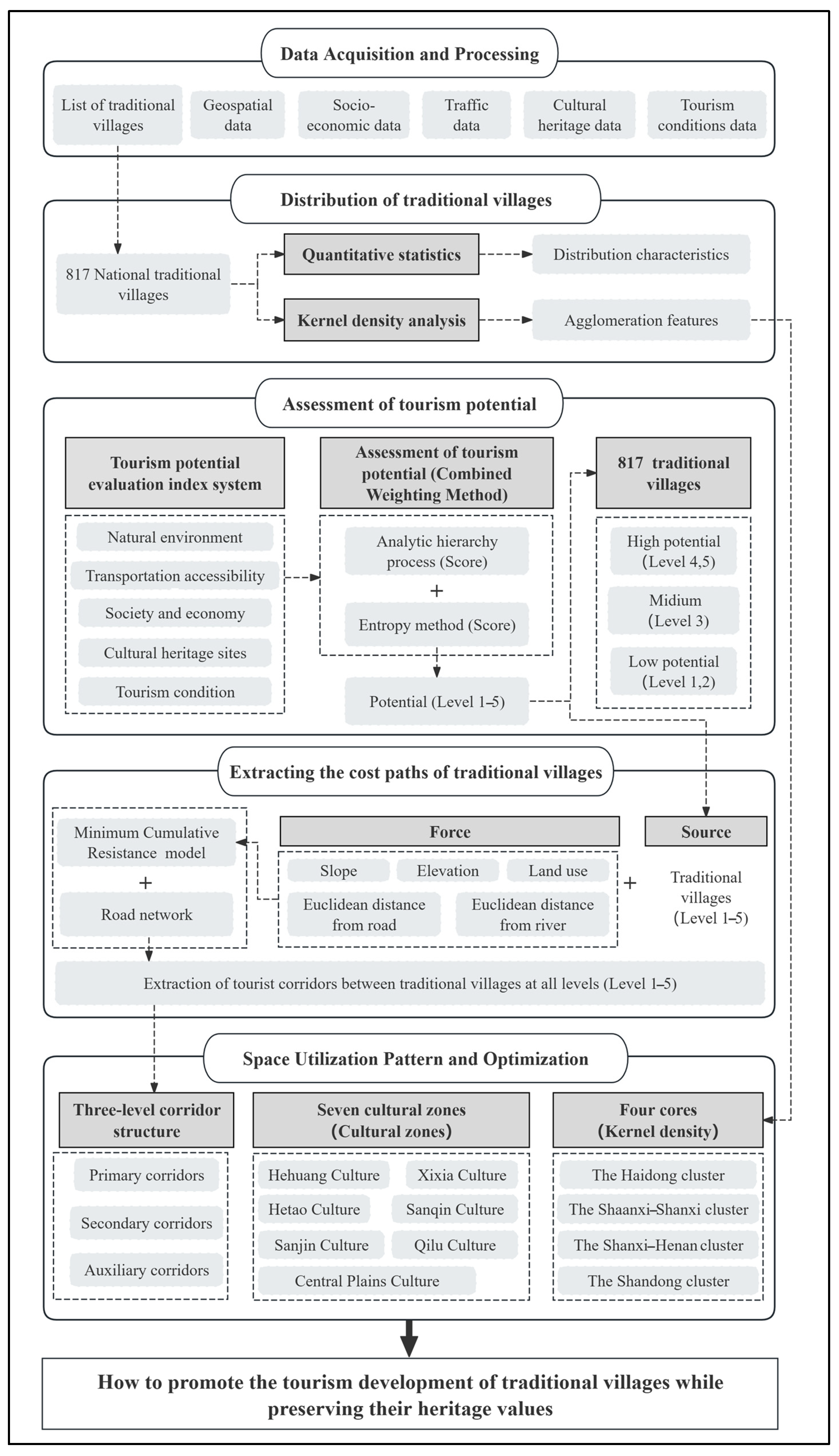
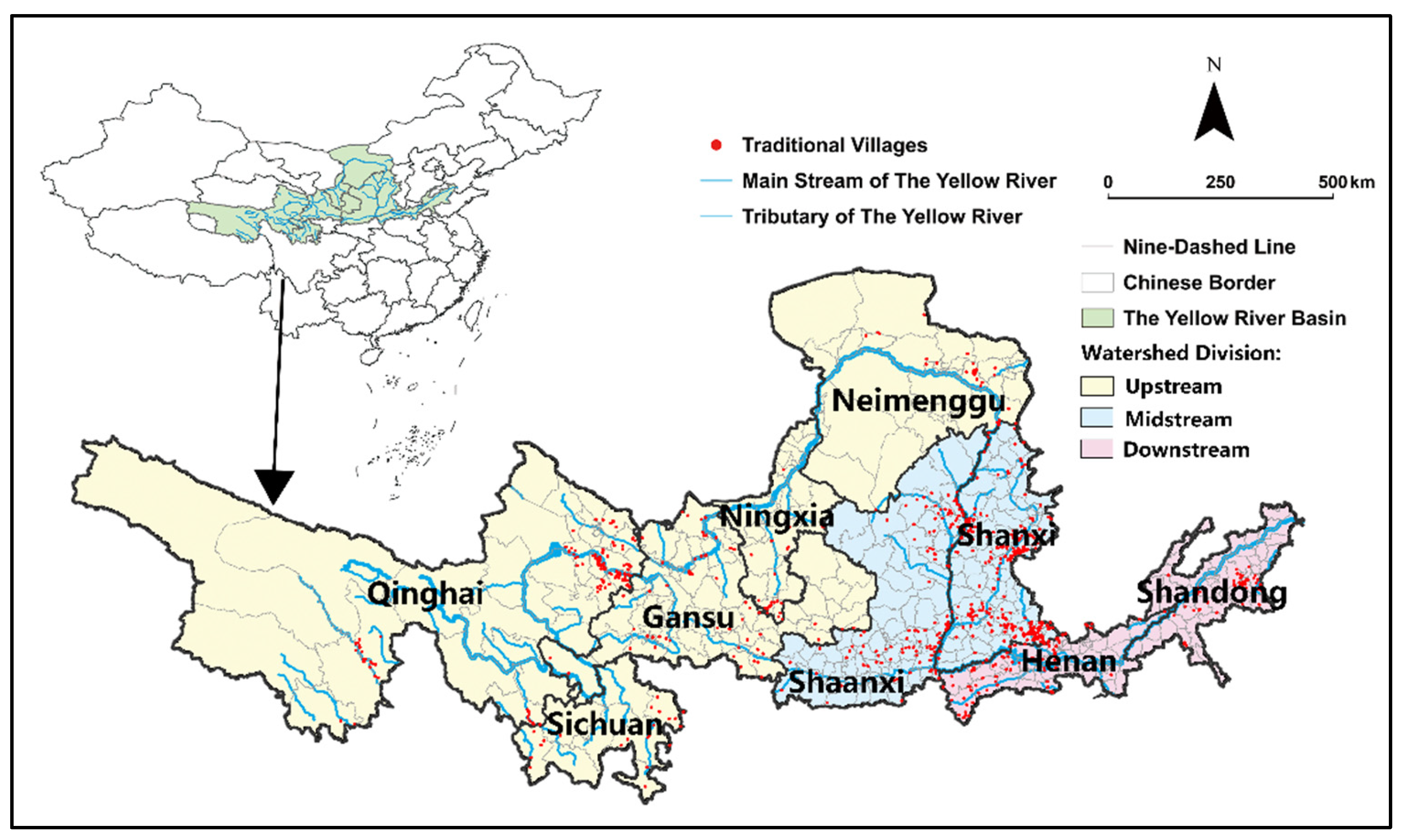
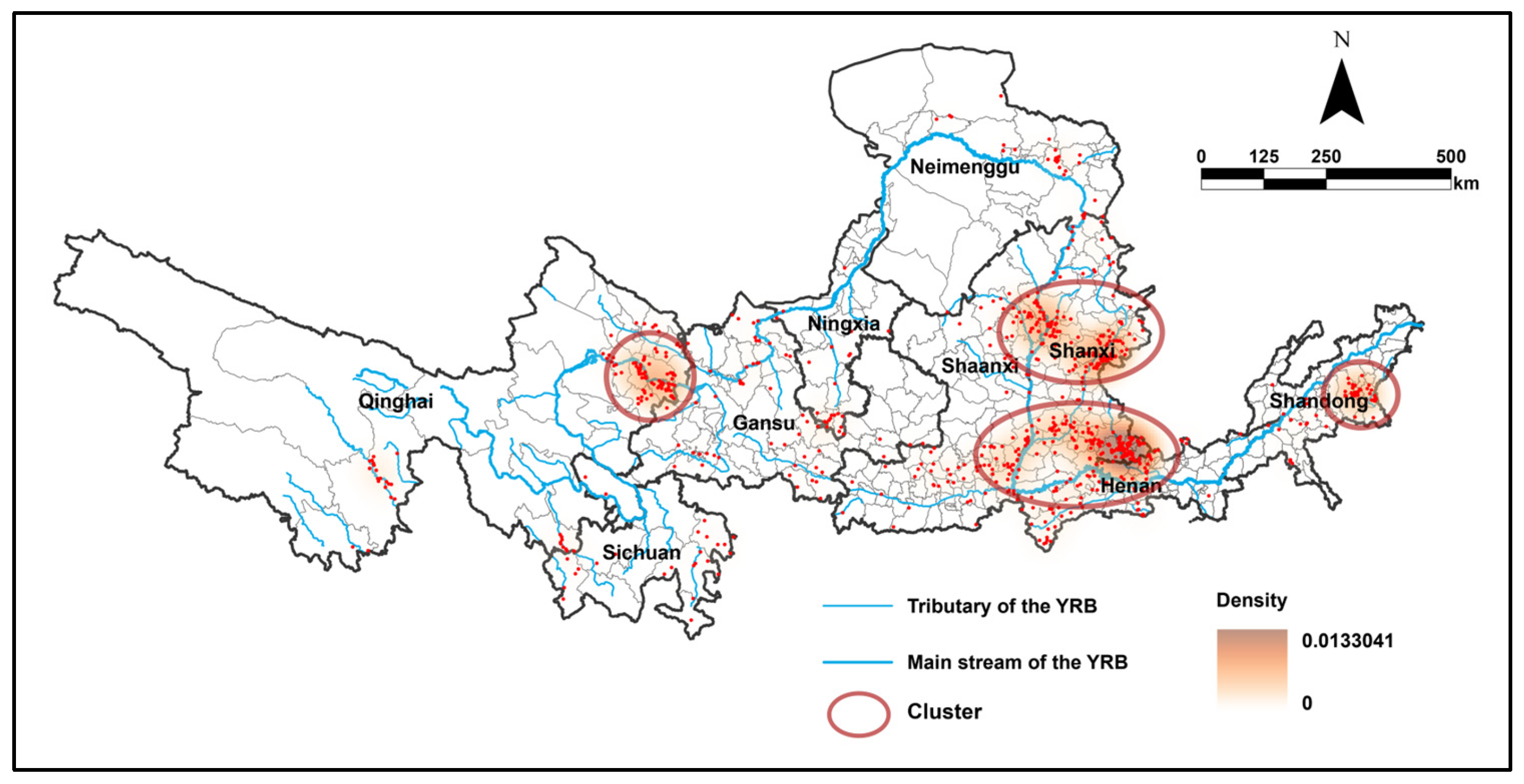
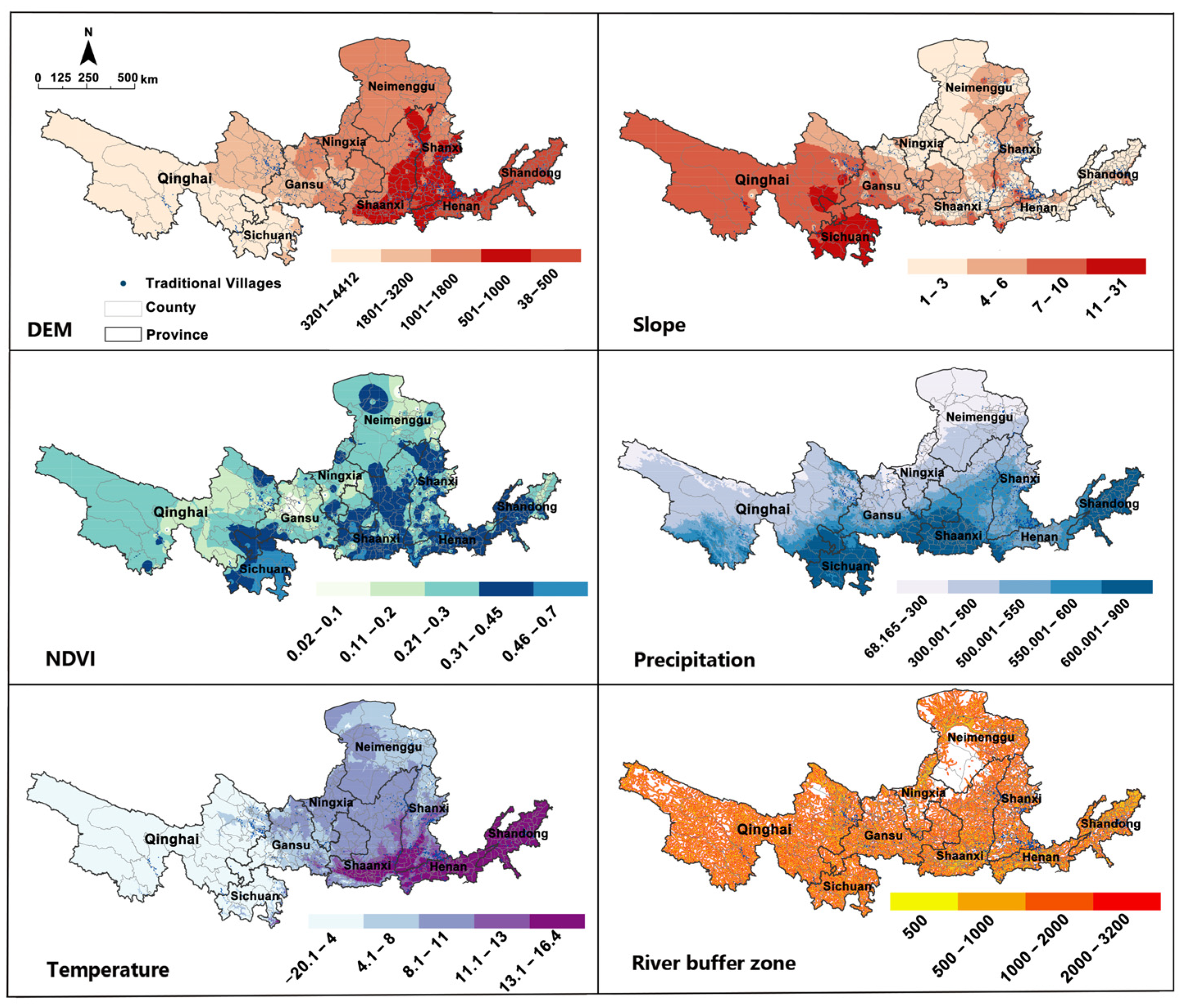
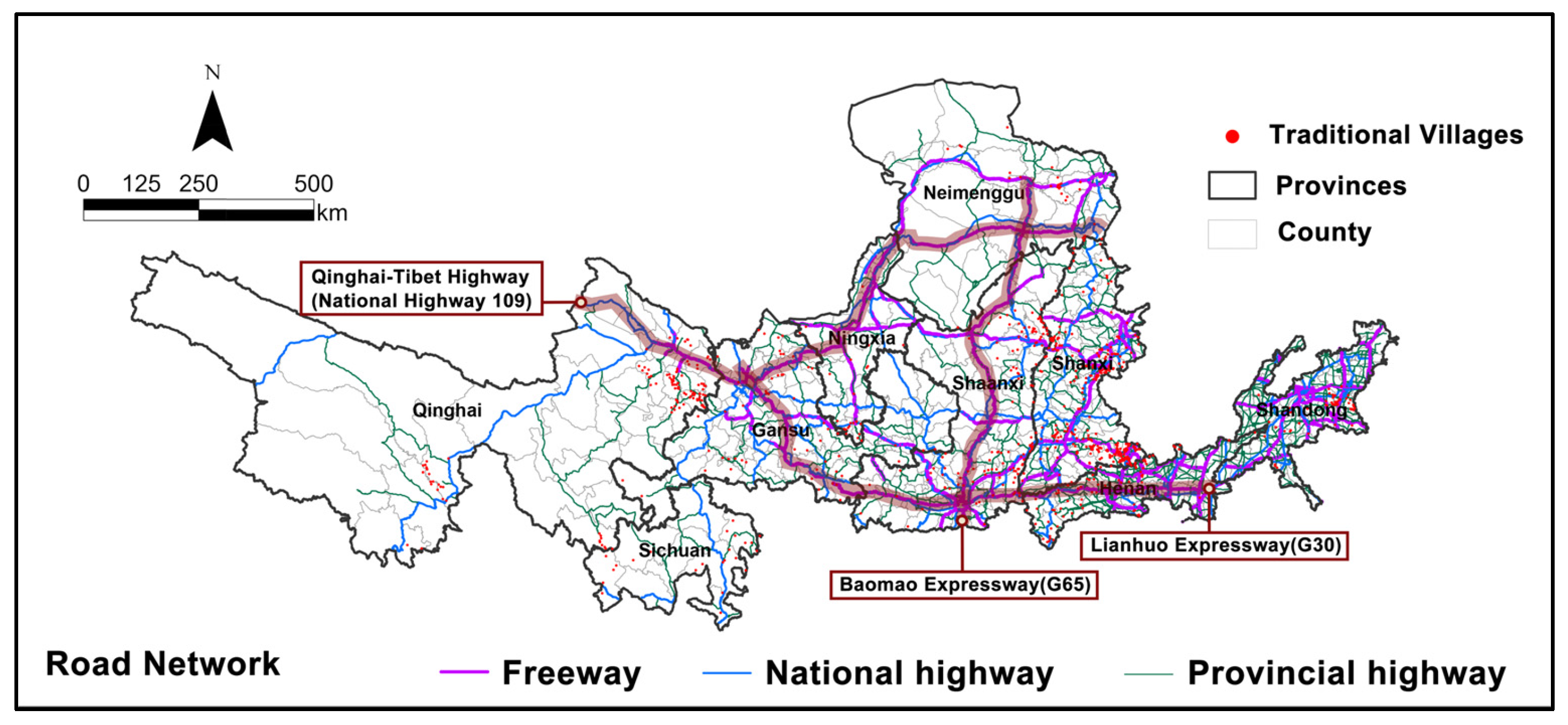
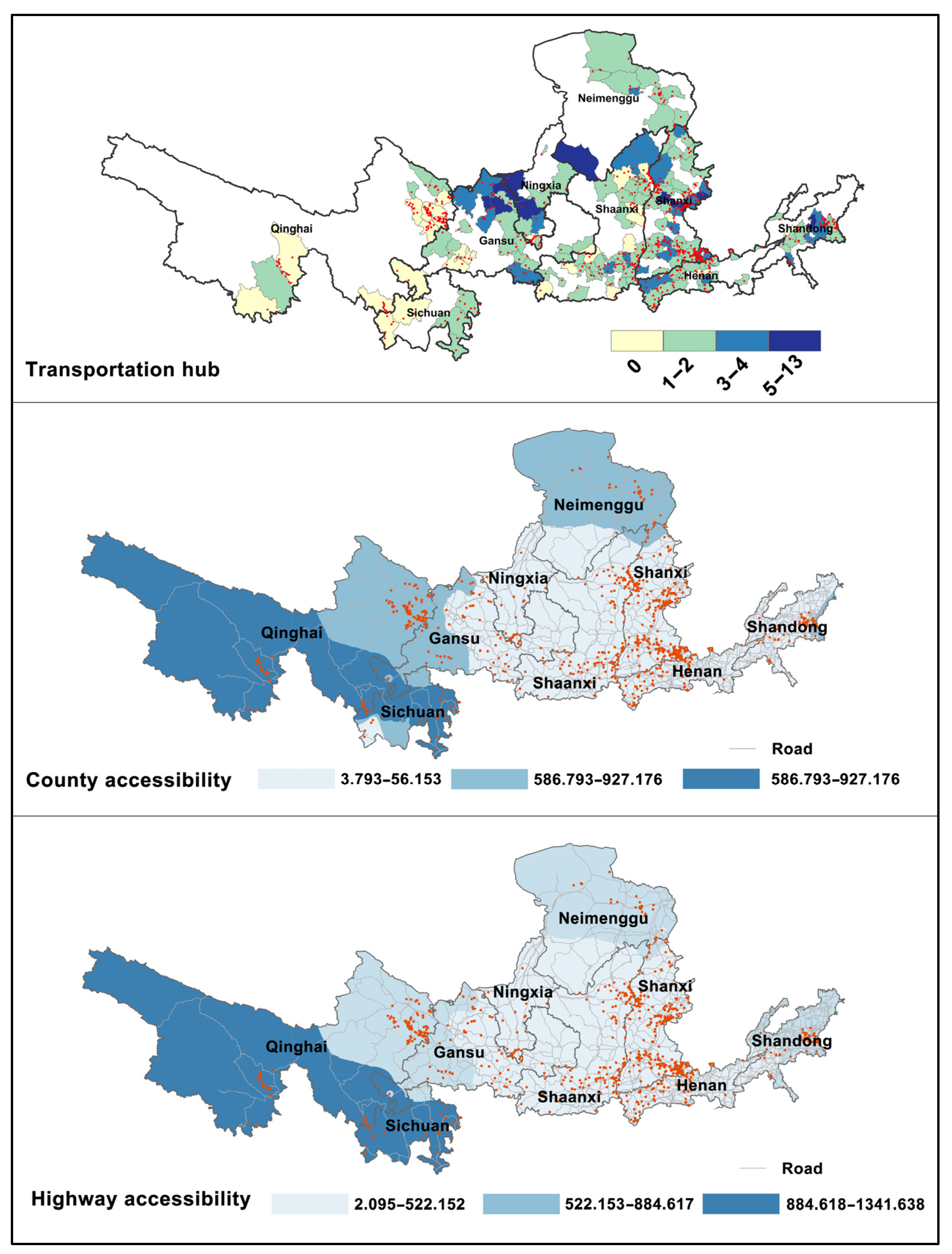
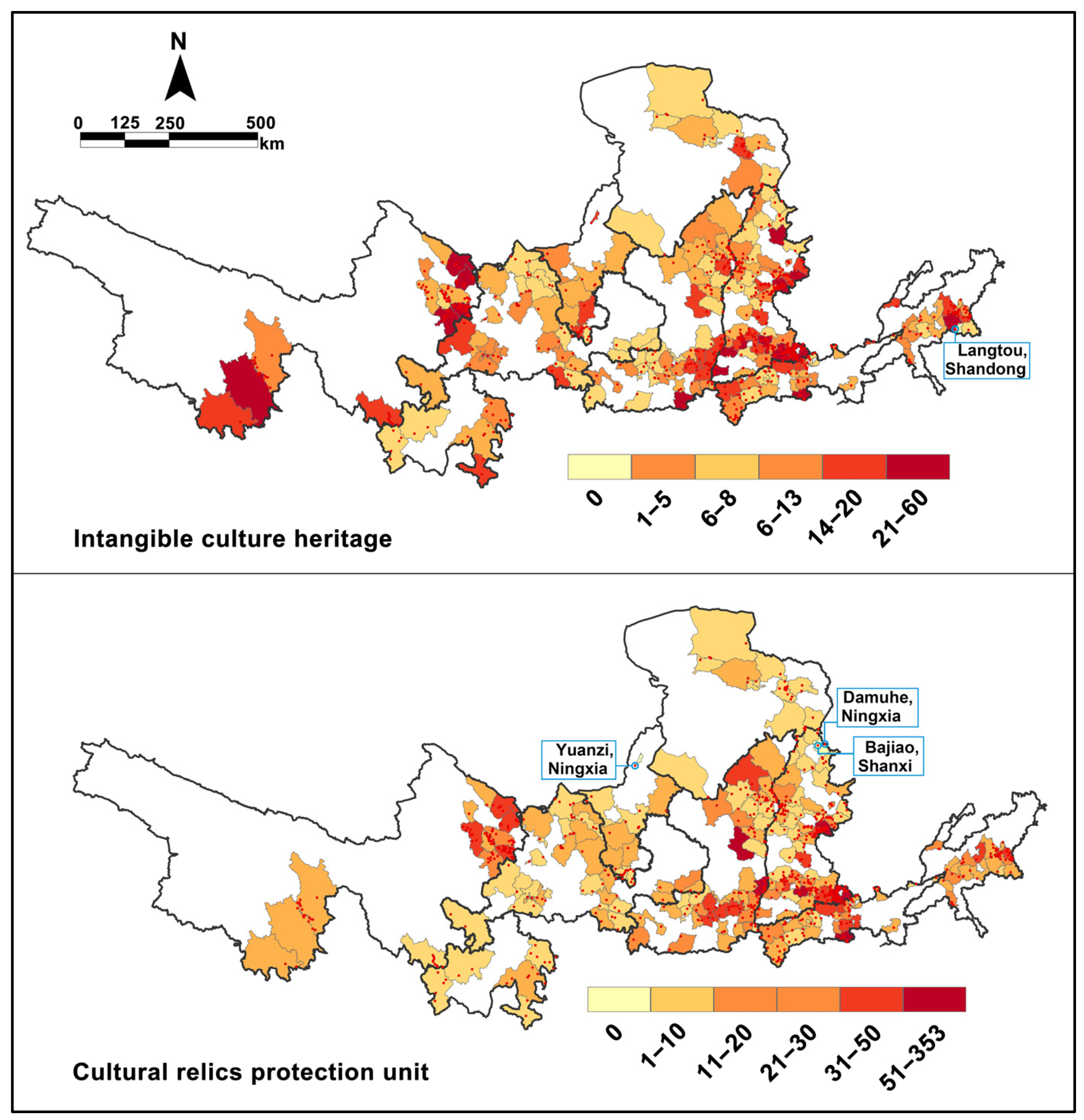
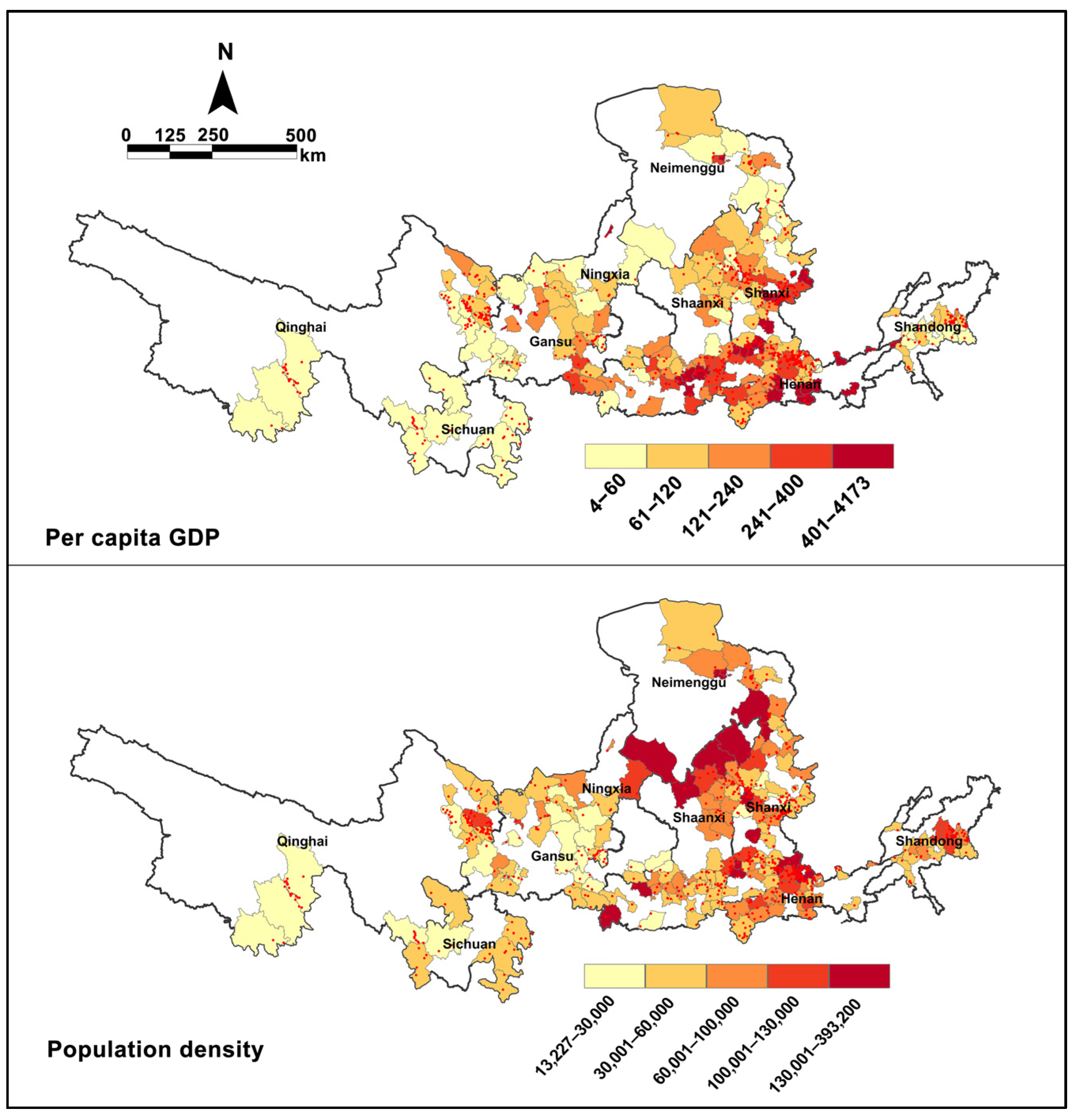
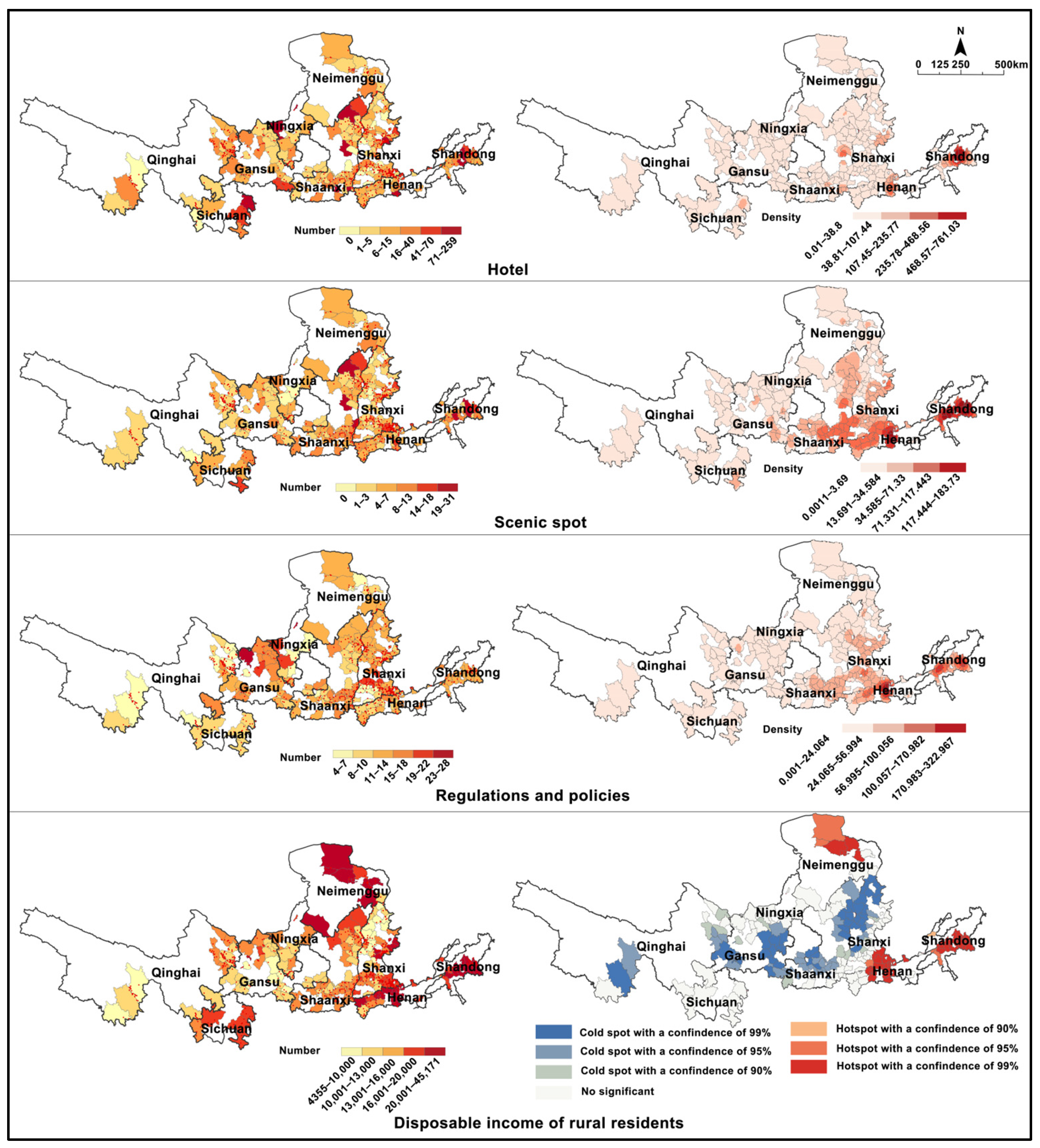
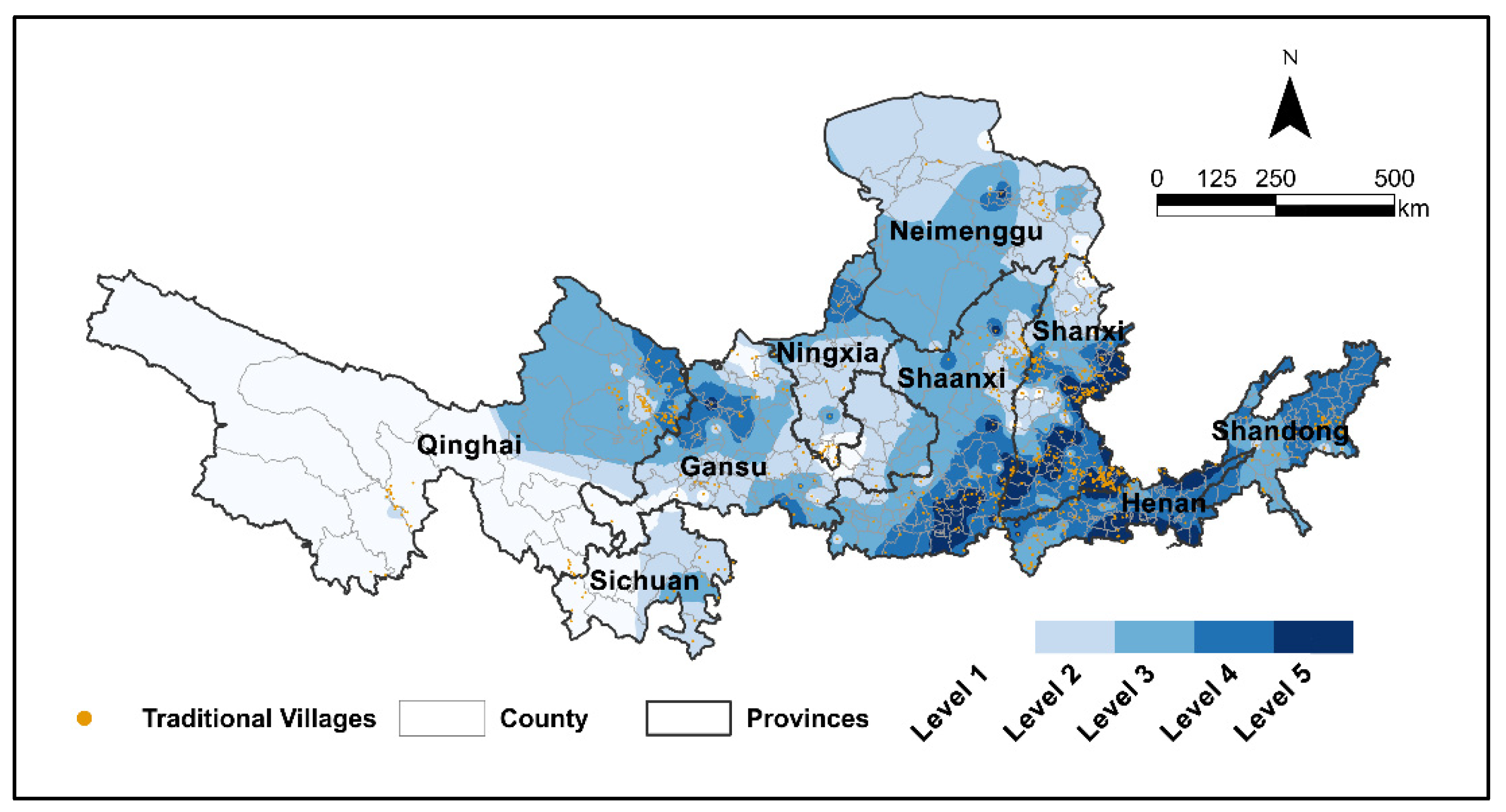

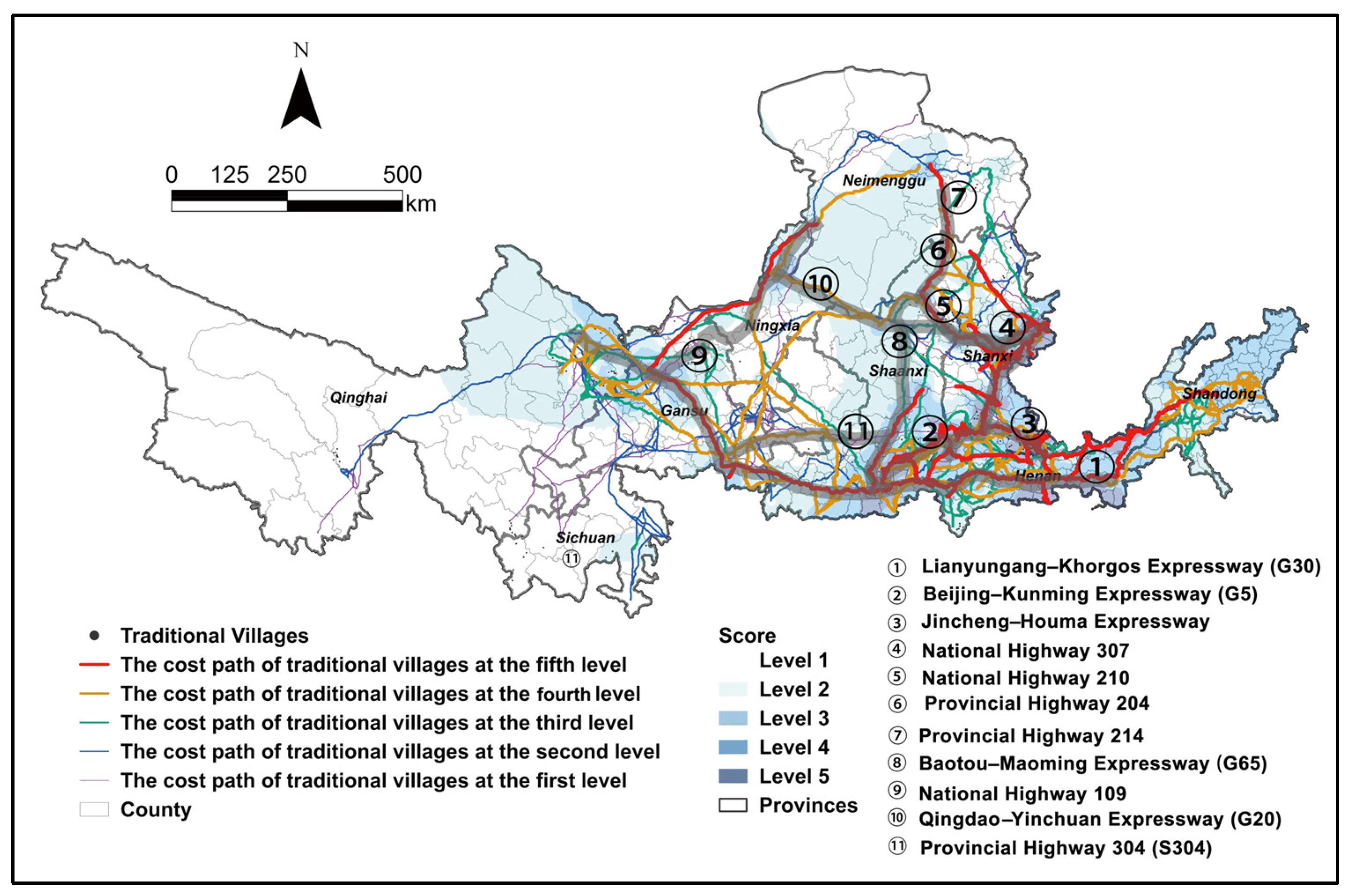
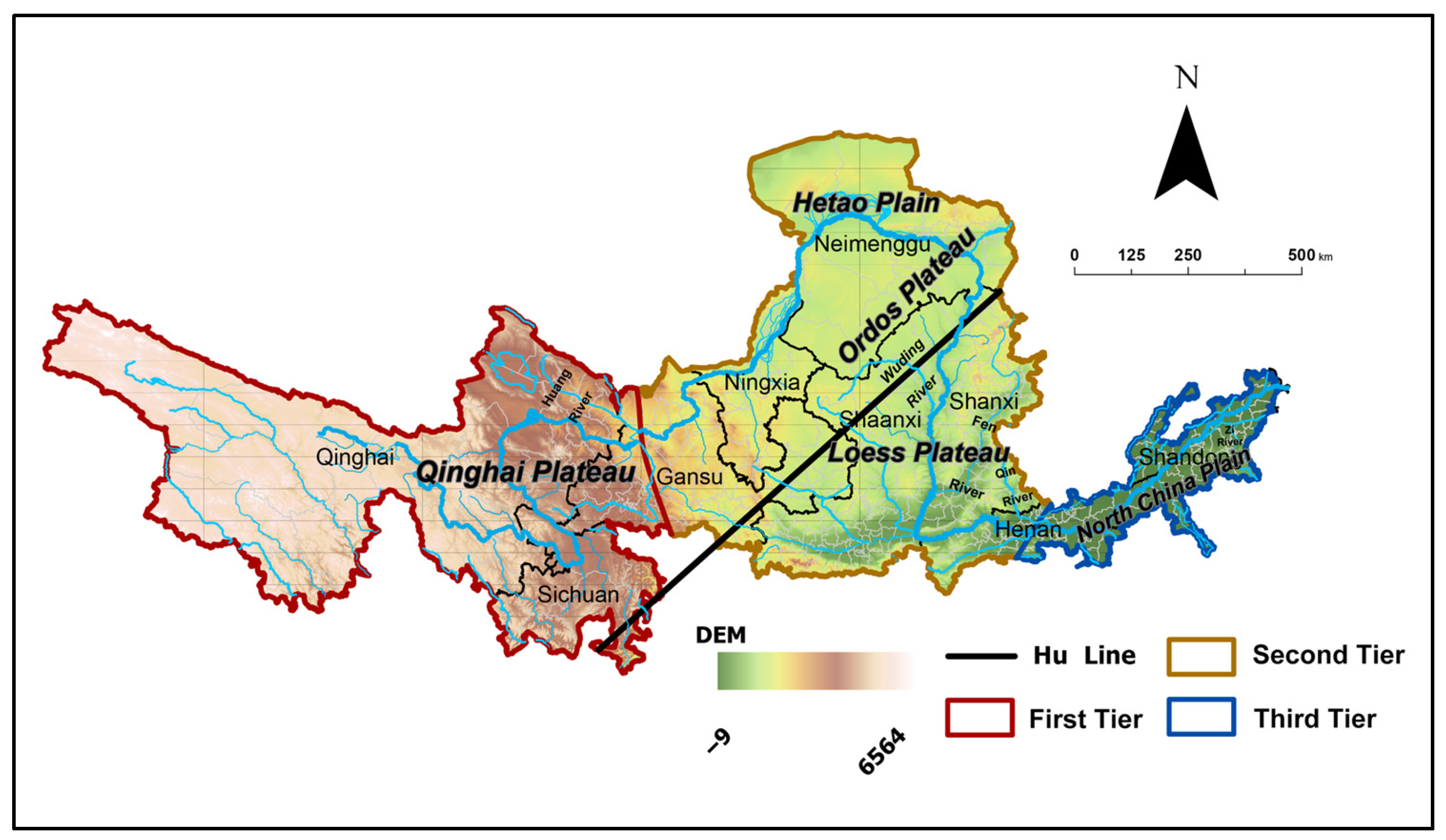
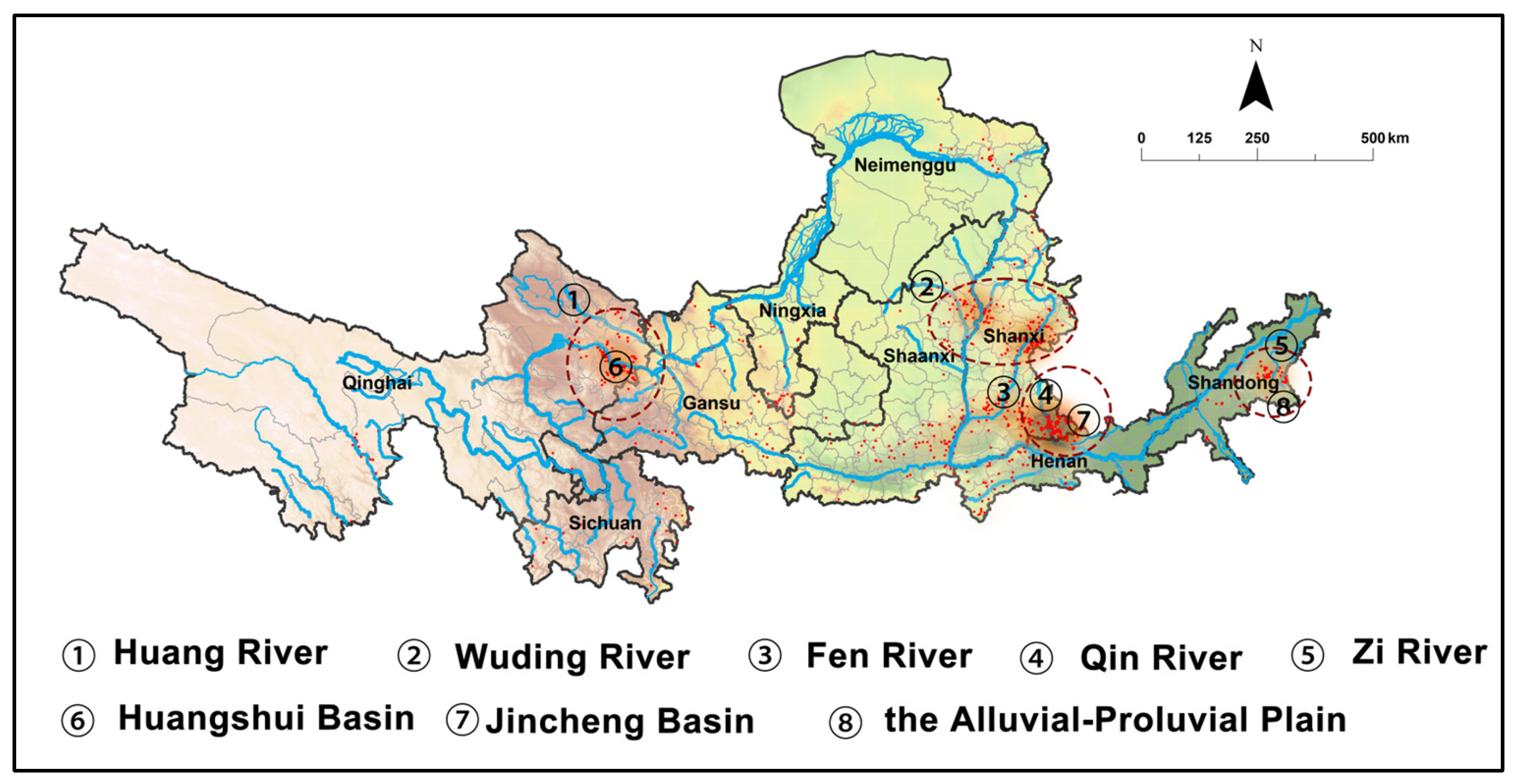

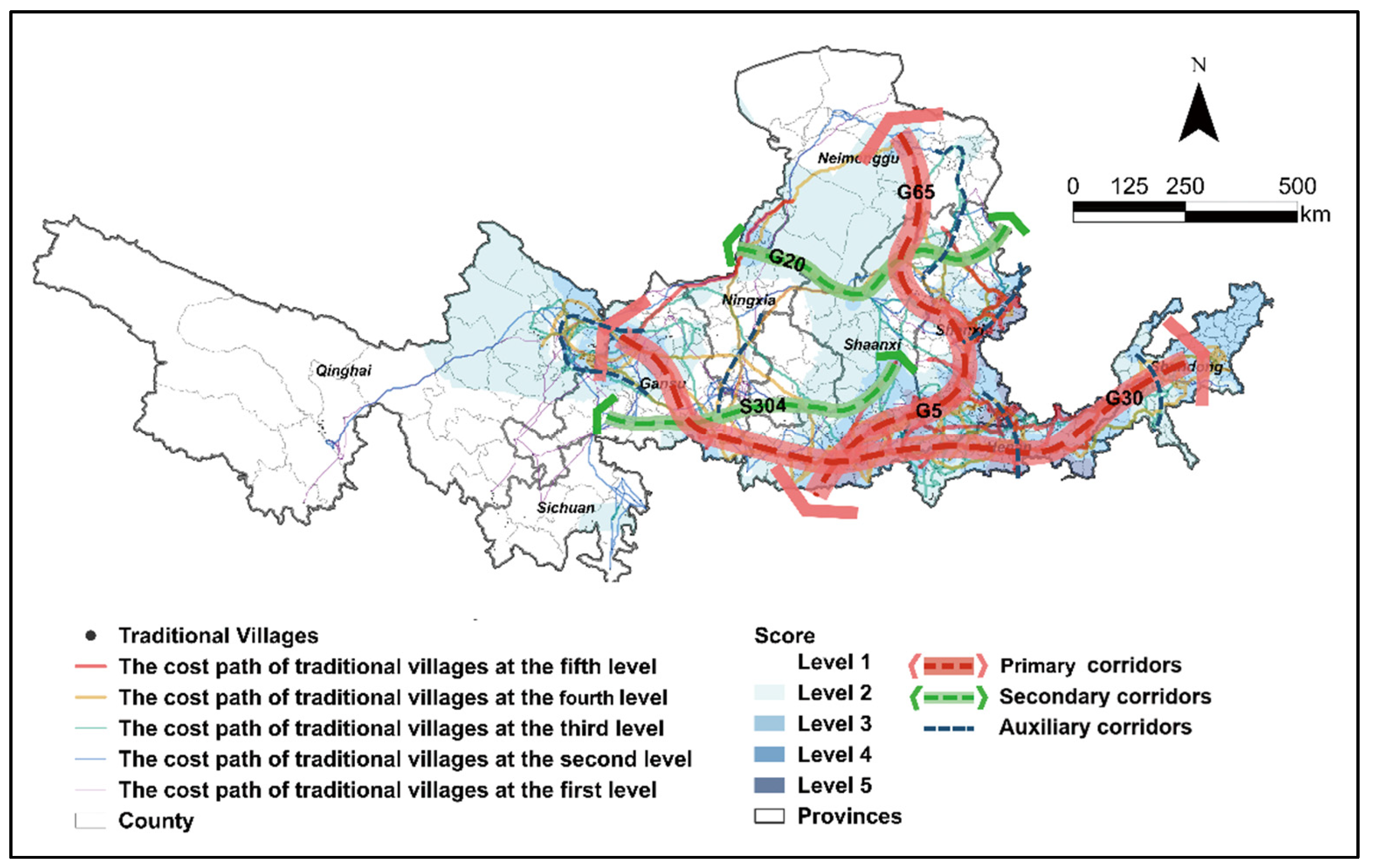
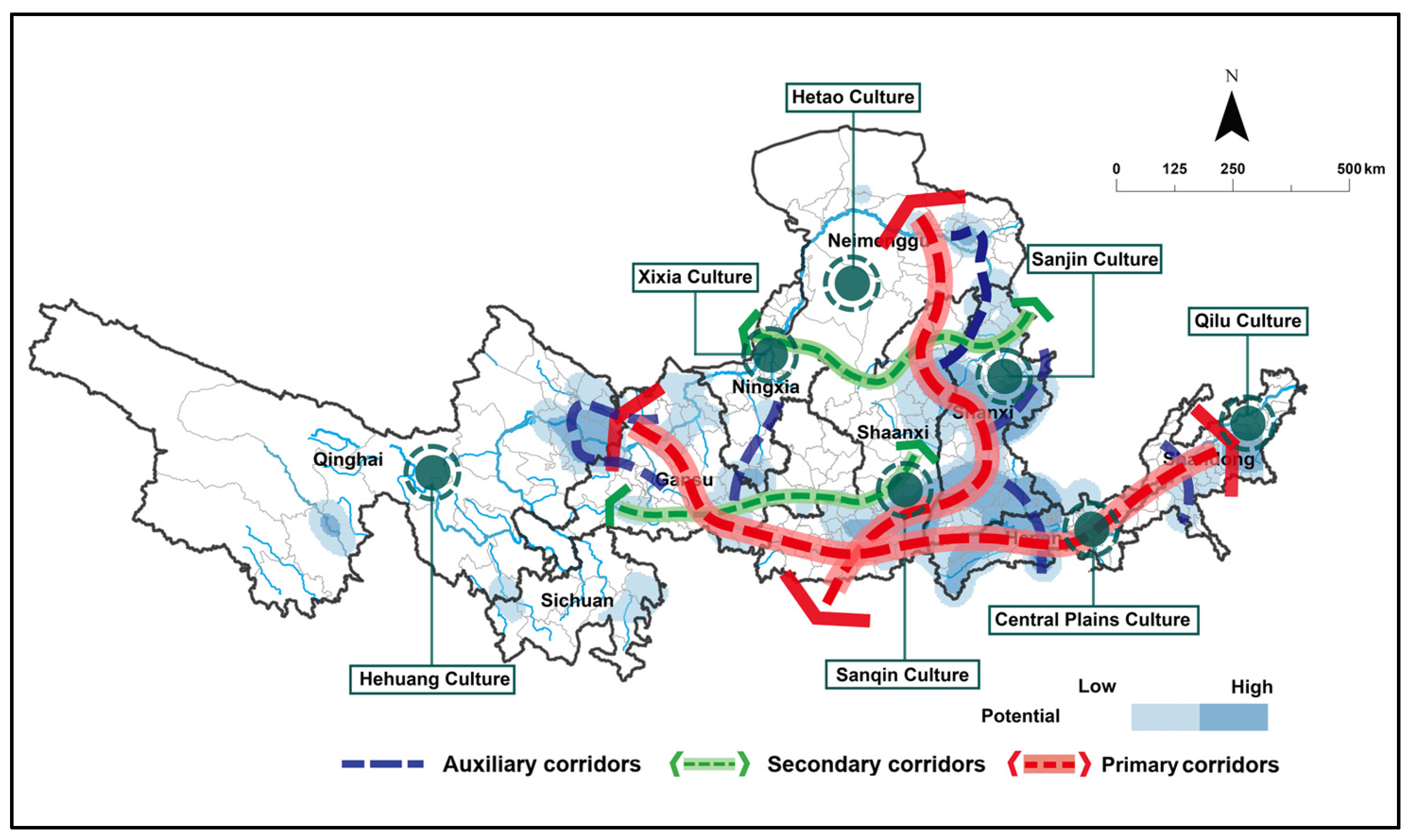
| Aspect | Indicators | Data Characteristics | Data Source | Dataset |
|---|---|---|---|---|
| Natural Environment | Slope | Raster | Geospatial Data Cloud (https://www.gscloud.cn/, accessed on 18 October 2024) | ASTER GDEM 30M resolution digital elevation data |
| Elevation | Raster | |||
| Distance from river | Raster | National Cryosphere Desert Data Center (https://www.ncdc.ac.cn/portal/, accessed on 18 October 2024) | Basic dataset of the Yellow River Basin (2002) | |
| Average temperature | Raster | National Tibetan Plateau Scientific Data Center Platform (https://www.tpdc.ac.cn/, accessed on 18 October 2024) | 1 km monthly mean temperature dataset for China (1901–2023) | |
| Precipitation | Raster | 1 km monthly precipitation dataset for China (1901–2023) | ||
| NDVI | Raster | China regional 250 m normalized difference vegetation index dataset (2000–2022) | ||
| Transportation accessibility | Number of railway stations, high–speed railway stations, airports | Vector | Get Points of Interest on Gaode map (https://lbs.amap.com/, accessed on 18 October 2024) | AutoNavi Map Open Platform |
| Travel time to the nearest highway entrance | Raster | Network analysis based on the Points of Interest on Gaode map (https://lbs.amap.com/, accessed on 18 October 2024). The speed limit on the expressway, national road and country road are separately 100, 80, 60 km/h. | ||
| Travel time to the nearest county | Raster | |||
| Society and economy | GDP per capita | TXT | Statistical Yearbook, Statistical Communique, and the Seventh National Population Census (https://www.stats.gov.cn/, https://www.baotaqu.gov.cn/ (as a sample), accessed on 18 October 2024) | The websites of the people’s governments of all districts and counties, National Bureau of Statistics of China |
| Population density | Raster | |||
| Cultural heritage sites | Number of national and provincial–level cultural relic protection units in the county | TXT | Cultural Heritage Administrations of China and various provinces (https://www.mct.gov.cn/, https://whhlyt.shaanxi.gov.cn/ (as a sample), accessed on 18 October 2024) | The official website of the cultural and tourism departments of all provincial, district and county regions |
| Number of national and provincial–level intangible cultural heritages in the county | TXT | |||
| Tourism condition | Number of hotels above three–star in the county | TXT | Get it from the Ctrip website (https://www.ctrip.com/, accessed on 18 October 2024) | Suppose the search situation is for one person in the same time period (3 March 2025–4 March 2025) |
| Number of regulations and policies related to cultural tourism at city and county levels | TXT | Statistical yearbooks, statistical bulletins and official websites of each city and county, and relevant government websites (http://www.haidong.gov.cn/ (as a sample), accessed on 18 October 2024) | The websites of the people’s governments of all districts and counties | |
| Disposable income of rural residents in counties | TXT | |||
| Number of scenic spots above 3A in the county | Vector | Get Points of Interest on Gaode map (https://lbs.amap.com/, accessed on 18 October 2024) | AutoNavi Map Open Platform |
| Resistance Factor | Weight | Direction |
|---|---|---|
| Elevation | 0.18 | Positive |
| Slope | 0.2 | Positive |
| Euclidean distance from road | 0.14 | Positive |
| Land use | 0.32 | Assignment (urban and rural, industrial and mining, residential land = 1; unused land = 2; water area = 3; grassland = 4; forest land = 5; cultivated land = 6) |
| Euclidean distance from river | 0.16 | Positive |
Disclaimer/Publisher’s Note: The statements, opinions and data contained in all publications are solely those of the individual author(s) and contributor(s) and not of MDPI and/or the editor(s). MDPI and/or the editor(s) disclaim responsibility for any injury to people or property resulting from any ideas, methods, instructions or products referred to in the content. |
© 2025 by the authors. Licensee MDPI, Basel, Switzerland. This article is an open access article distributed under the terms and conditions of the Creative Commons Attribution (CC BY) license (https://creativecommons.org/licenses/by/4.0/).
Share and Cite
Liu, X.; Wu, T.; Xie, Z.; Yuan, W.; Yang, H. Creating the Spatial Utilization Pattern of Traditional Villages in the Yellow River by Connecting the Heritage Corridors System with the Assessment of Tourism Potential. Land 2025, 14, 1402. https://doi.org/10.3390/land14071402
Liu X, Wu T, Xie Z, Yuan W, Yang H. Creating the Spatial Utilization Pattern of Traditional Villages in the Yellow River by Connecting the Heritage Corridors System with the Assessment of Tourism Potential. Land. 2025; 14(7):1402. https://doi.org/10.3390/land14071402
Chicago/Turabian StyleLiu, Xin, Tangxia Wu, Ziyi Xie, Weijing Yuan, and Huan Yang. 2025. "Creating the Spatial Utilization Pattern of Traditional Villages in the Yellow River by Connecting the Heritage Corridors System with the Assessment of Tourism Potential" Land 14, no. 7: 1402. https://doi.org/10.3390/land14071402
APA StyleLiu, X., Wu, T., Xie, Z., Yuan, W., & Yang, H. (2025). Creating the Spatial Utilization Pattern of Traditional Villages in the Yellow River by Connecting the Heritage Corridors System with the Assessment of Tourism Potential. Land, 14(7), 1402. https://doi.org/10.3390/land14071402








